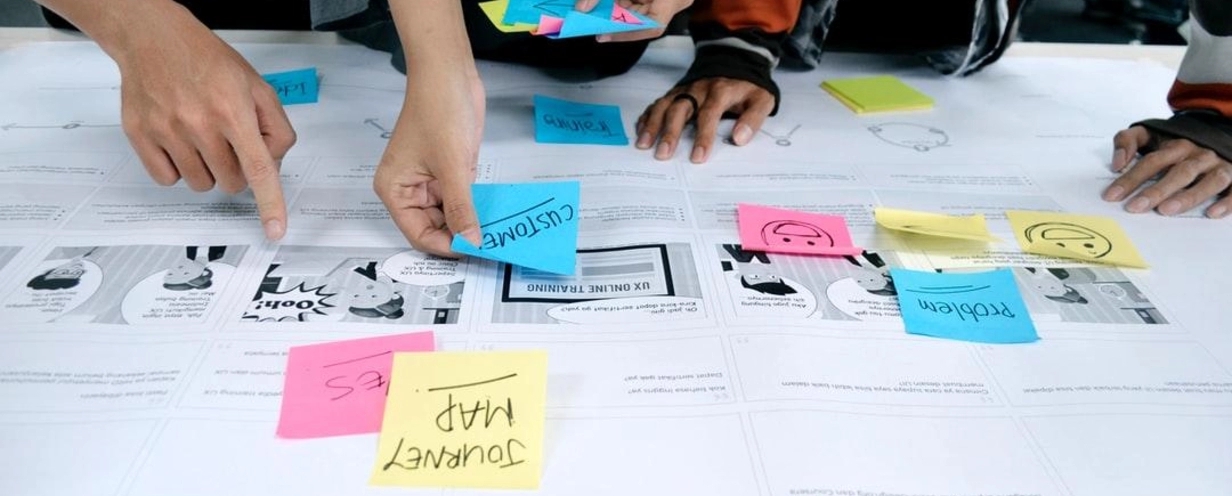
What is the Lean UX process?

At its core, the Lean User Experience approach is about putting users first. It's an iterative design process emphasizing feedback, collaboration, and waste minimization so that products or services cater to users' needs.
Below, we'll dissect the methodology by exploring key components such as continuous discovery, shared understanding, and valuing every team member. You'll also learn how to implement lean UX design in your organization to shorten the iteration period and develop customer-centric products.
What is the Lean UX process?
Lean UX, or lean user experience, is a design methodology grounded in the principles of the Lean and Agile development processes. Jeff Gothelf first introduced the process in his book, Lean UX.
Lean UX focuses on delivering innovative user experience improvements as efficiently as possible. It emphasizes iterative design and continuous customer feedback, making it adaptable and responsive to changing user needs. Working through cycles of brainstorming concepts, creating prototypes, testing, and learning, organizations employ the Lean UX process to rapidly innovate and improve their products.
Let's say a software company is introducing a new feature in its application. With Lean UX, the team wouldn't spend months designing and developing the full feature. Instead, they'd create a simple version or minimum viable product (MVP) and release it to a subset of their users. Then, they'd collect problem statements and customer feedback to learn what works and what doesn't. They'd continue iterating improvements even after the product has been released.
How the Lean UX process works

The exact steps may vary depending on your organization's objectives, but generally, the Lean UX design process involves three major steps.
Think
The Think phase is the foundation for the rest of the Lean UX process. It's about understanding and defining the problem that needs to be solved based on your user's feedback. In this phase, your design teams should already have a well of customer data relevant to the outcome you want to accomplish.
Your team brainstorms a hypothesis using this data to guide the design process. Then, you synthesize all data into user personas, which help designers empathize with users and create solutions tailored to their needs.
Suppose a lean startup wants to introduce a new feature on its mobile app that allows users to customize their app interface. In the Think phase, the team might come up with the following hypothesis: By allowing users to customize the app interface, user engagement will increase by 20%. They'd also define success metrics, such as the optimal number of users using the customization feature, the amount of time spent on the app, and user satisfaction scores.
Make
Ideas start to take shape at this stage of the Lean UX process. Your team quickly transforms hypotheses into tangible prototypes you can test with real users. The goal isn't to create a perfect product at this stage but to learn as much as possible about user needs and preferences for future iterations.
Teams can use various tools and techniques, such as wireframing and prototyping, to create low-fidelity versions of their solutions. This could be a simple paper sketch of an app interface or a clickable MVP created with software like Sketch or Figma.
Check
After you've created your prototype, you'll use it to perform a small set of user tests. You'll collect data on real users and analyze the results to validate or refute your initial hypothesis.
During the check phase, it's common to use usability testing sessions, surveys, and interviews to gather qualitative and quantitative data on how the users interact with the prototype. Pay close attention to whether users can complete tasks efficiently if they understand how the product works, and how satisfied they are with the overall experience.
By analyzing the data from these tests and surveys, you can assess whether your design has achieved your desired outcomes. If the results are positive and there's minimal feedback for improvement, the feature may be ready for full-scale development and release. If not, you take the learnings back into the think phase, refining your hypothesis and starting the cycle again.
The 12 principles guiding Lean UX
There's much to customize during the Lean UX process, but you can go in with structure. Here are the key guiding principles to effectively approach Lean UX in your organization.
1. Small, dedicated teams
The idea behind this first principle is that a small group of people fully dedicated to a project can work more efficiently and effectively than a larger team of individuals juggling multiple projects. Small teams are more agile, able to make decisions faster, pivot when necessary, and focus strongly on the user experience.
In the context of Lean UX, the ideal team size is typically anywhere from five to nine employees. All stakeholders working on the project should be focused on achieving the same goal. Additionally, your team is likely to be more productive and effective if they're all in the same location, where they can directly communicate.
2. Cross-functional teams
This concept involves bringing together individuals with different skill sets and expertise to form a single team handling various aspects of the project. Cross-functional teams eliminate the silos that often exist in traditional organizational structures.
For instance, you might find product managers, content strategists, data analysts, designers, and developers in a single cross-functional team. Each member brings a unique perspective to the table, ensuring a more holistic approach to problem-solving. Also, this multidisciplinary setup allows for a more comprehensive understanding of the project.
3. Progress as outcomes
In the Lean UX process, outcomes, not output, measure progress. This principle shifts the focus from producing a high quantity of work (output) to achieving meaningful results (outcomes) that align with your goals and meet user needs.
In traditional methods, you might measure success by the number of added features or tasks completed. However, in Lean UX, what's more important is whether additions lead to improvements in user experience, such as higher conversion rates or customer satisfaction.
4. Problem-focused teams
As you monitor outcomes, your team needs to be vigilant in addressing the problems your users are having with your product or service. By keeping user problems at the forefront, your team will be ready to prioritize development improvements that address the core pain points of your audience.
Teams should regularly ask themselves: What are we trying to solve? How can we make the experience better for our users? What existing problems do users want fixed before we develop new features? By focusing on the problem first, you can make sure every feature you design serves a clear purpose and adds real value for the people using your app or website.
5. Waste reduction
When it comes to Lean UX, waste refers to any activity that does not contribute to the final user experience or deliver value to the customer. The goal is to streamline the design process, making it as efficient and effective as possible. This could involve eliminating unnecessary meetings, reducing documentation, and avoiding over-engineering solutions.
Reducing waste not only speeds up the design process but also fosters a culture of continuous improvement. It encourages teams to constantly evaluate and refine their processes, always seeking ways to work smarter, not harder.
6. Small batch sizes
Breaking down work into smaller, more manageable parts means you can deliver results rapidly and get quicker feedback. Working in small batches allows teams to test and validate their ideas sooner, which reduces the risk of spending too many resources on features or improvements that don't meet users' needs.
Consider a company designing a new e-commerce website. Instead of building the entire site at once, the team could break the project down into smaller batches, focusing on core features like landing pages or the shopping cart.
7. Continuous discovery
With continuous discovery, your team gains insights through ongoing learning and exploration across the product development cycle. Rather than treating user research as a one-time activity at the beginning of the project, continuous discovery encourages teams to constantly gather and integrate user feedback to inform the entire process. This could involve conducting interviews, surveys, usability tests, or other forms of user research on an ongoing basis.
The continuous discovery approach ensures that the product remains user-centric throughout its development. It also allows teams to catch potential issues early when they are easier and cheaper to fix.
8. Shared understanding
Shared understanding, often fostered through collaboration between teams, is a key principle in the Lean UX process. This principle suggests that for a product to be truly user-centric, all team members should be on the same page about users' needs, project goals, and the rationale behind design decisions. Many teams opt to incorporate the Scaled Agile Framework, or SAFe, which integrates principles form lean thinking, agile development, and DevOps to optimize efficiency and collaboration across teams.

Open communication and close collaboration are two key tenets to creating a shared understanding within all departments. Rather than operating in silos, team members should work together, share insights, discuss ideas, and make decisions collectively.
9. Get out of the building (GOOB)
GOOB emphasizes the importance of direct interaction with users and the real-world context of a product. Instead of getting lost in internal debates or assumptions, you should seek out firsthand insights and feedback from users.
While not every team member may need direct contact with users, they should at least be aware of feedback and results from user interviews, field studies, usability tests, and other primary research methods. The goal is to gain a deep, empathetic understanding of the people's needs, behaviors, and contexts, which can then inform design decisions.
10. Value for every team member
Instead of praising the work of one individual who acts as an example for others to follow, Lean UX is about valuing every team member involved. The small team sizes and intense effort required to make adaptive changes means every member has a significant impact on the outcome.
Making every team member feel valued promotes a shared sense of ownership and accountability. It fosters a culture of respect where employees care about the work they deliver and invest more effort into achieving success.
11. Learning over growth
The idea behind this principle is not to get caught up in perfecting your product. Instead, prioritize what changes need to happen today to get immediate customer feedback. In other words: Build the right thing first, then scale.
By committing to learning over growth, your team prevents itself from getting bogged down in features or improvements that don't add value to the user experience. Instead, teams concentrate on adapting their product to meet the needs of their users, even if it means starting small and gradually growing over time.
13. Embracing failure
To move at the speed required for Lean UX, teams must embrace failure, not shy away from it. Failure isn't only inevitable — it's also a valuable learning opportunity for your team. In Lean UX, failures are a source of insights that can inform future decisions and improvements. The idea is to fail fast and fail often so you can learn and make rapid progress.
Encourage teams to take risks, experiment, and keep striving for better. Create a safe environment where team members feel comfortable making mistakes.
The impact and benefits of a Lean UX process
Many organizations waste time laboring over traditional UX processes, trying to create the best product available without listening to actual users. The Lean UX process shifts the focus from creating a perfect product to continually improving it based on real-world feedback. Teams create a hypothesis to test, build prototypes, and collect user data as quickly as possible to speed up the iteration process. Consider using Lean UX if you want a user-centric development process that streamlines workflows.

Watch a demo
See how easy it is to get fast feedback on a website, prototype, design, or more in this demo.





